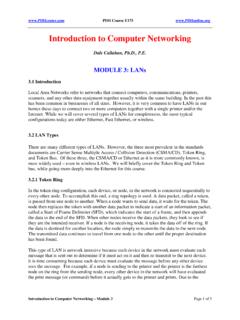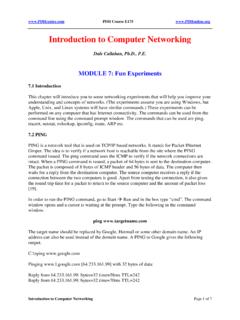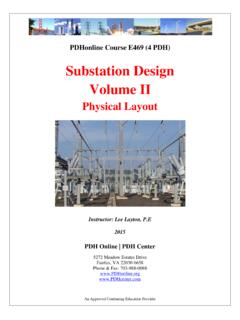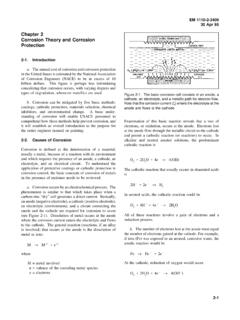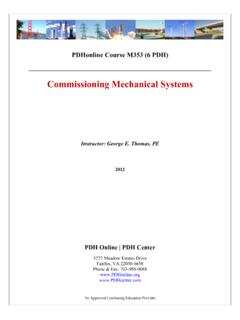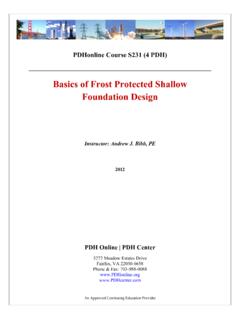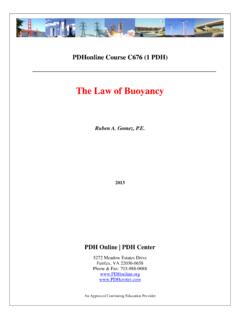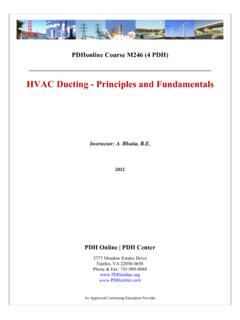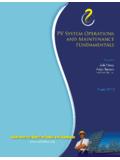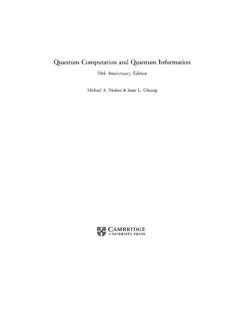Transcription of Calculating Currents in Balanced and Unbalanced Three ...
1 An Approved Continuing Education Provider PDH Course E336 Calculating Currents in Balanced and Unbalanced Three Phase Circuits Joseph E. Fleckenstein, 2013 PDH Center 5272 Meadow Estates Drive Fairfax, VA 22030 USA Phone: 703-988-0088 i Calculating Currents in Balanced and Unbalanced Three Phase Circuits Joseph E. Fleckenstein, Table of Contents Section Description Page 1. Introduction .. 1 2. General Information .. 2 2A. Common Electrical Services .. 2 2B. Instantaneous Voltage and Instantaneous Current .. 3 2C. RMS Voltage and RMS Current .. 5 3. Single Phase Circuits .. 8 3A. Single Phase Resistive 8 3B. Leading and Lagging Power Factor .. 10 3C. Phasor Diagrams of Single Phase Circuits.
2 12 3D. Parallel Single Phase Loads .. 15 3E. Polar 17 4. Balanced Three Phase Circuits .. 18 4A. Voltages in Three Phase Circuits - General .. 18 4B. Calculation of Power in a Balanced Three Phase Circuit .. 20 4C. Phasor Diagrams of Three Phase Circuits .. 22 4D. Calculating Currents in a Balanced Three Phase Delta Circuit General .. 23 Resistive Loads .. 23 Capacitive Loads .. 27 Inductive Loads .. 29 Two or More Loads .. 31 4E. Calculating Currents in a Balanced Three Phase Wye Circuit - General .. 38 Resistive 39 Inductive Loads .. 40 Capacitive Loads .. 41 5. Unbalanced Three Phase Circuits .. 41 5A. Unbalanced Three Phase Circuits - General .. 41 PDH Course E336 ii 5B Unbalanced Three Phase Delta Circuits with Resistive, Inductive or Capacitive Loads - General.
3 41 Unbalanced Three Phase Delta Circuits with Resistive, Inductive or Capacitive Loads .. 42 Unbalanced Three Phase Delta Circuit with Only Resistive Loads .. 51 5C. Unbalanced Three Phase Wye Circuit .. 54 5D. Combined Unbalanced Three Phase Circuits .. 56 5E. Power Computation and Power Factor .. 67 6. Summary of Course 69 7. Summary of Symbols and Equations .. 70 7A. 70 7B. Equations .. 71 8. References .. 81 Joseph E. Fleckenstein 1 COURSE CONTENT 1. Introduction The importance of Three phase circuits is well recognized by those who deal with electricity and its use. Three phase electrical sources are the most effective means of transmitting electrical current over long distances and Three phase motors offer many advantages over single phase motors.
4 While the electrical service delivered to residences in the United States is commonly single phase, larger users typically are served with a Three phase electrical service. In general Three phase loads are considered either Balanced or Unbalanced . A Three phase circuit is considered Balanced if the voltages, Currents and power factors in all Three phases are identical. Conversely, when any of these parameters are not identical the circuit is classified as Unbalanced . The computations of electrical properties of Balanced loads are relatively straightforward and may be performed by simple computations. On the other hand, the calculations of the electrical properties of Unbalanced Three phase circuits become somewhat more complicated.
5 To determine Currents in Unbalanced circuits a greater understanding of the subject is required. For a variety of reasons it often becomes necessary to calculate the Currents in both Balanced and Unbalanced Three phase circuits. For example, the magnitude of the Currents may be needed to properly size conductors, conduits, relays, fuses, circuit breakers, transformers and the like. Furthermore, the calculations of Currents are often needed to demonstrate that an installation will be in accordance with applicable codes, as the National Electrical code (NEC). This course presents the means for Calculating Currents in the conductors of both Balanced and Unbalanced Three phase circuits. Numerous diagrams and examples are used to illustrate the principles that are involved in relatively simple concepts.
6 Balanced circuits are treated first. The principles pertinent to Balanced circuits provide a convenient basis for the principles used to analyze the more complicated Unbalanced circuits. The concept of phasors is introduced first with Balanced circuits. Subsequently, the step to using phasors diagrams to analyze Unbalanced circuits is easily taken. PDH Course E336 Joseph E. Fleckenstein 2 As demonstrated in the course, phasors diagrams assist a person to visualize what is happening in an electrical circuit. By a technique commonly known as vector-algebra, phasor diagrams are combined with algebraic expressions to explain, in simple terms, how Currents are calculated in the respective Three phase circuits.
7 The resulting equations that are applicable to the various types of circuits are introduced in cookbook fashion. The result is that Currents may be calculated by easily applied methods. The course considers the two common types of Three phase circuits, namely the common delta circuit (which is so named because of the resemblance of the configuration to the Greek symbol ) and the wye circuit which is also called a star or Y circuit. Unbalanced Three phase circuits often present the need to calculate line Currents based on knowledge of phase Currents and power factors. Another frequently encountered need is the requirement to determine net line Currents in a feeder that delivers power to a mix of two or more Three phase loads each of which may be in a delta or a wye circuit and Balanced or Unbalanced .
8 The course offers methods to meet all of these needs by means of easily followed procedures. Complex variables as well as polar notations are often found in texts on the subject of Three phase electricity. At times both can be helpful to understand and resolve Three phase computations. On the other hand, their use can introduce complications and confusion. For this reason neither complex variables nor polar notation are used in the computations of the course. Nevertheless, the relationship between the often-used polar notation and the symbology of the course is briefly explained. 2. General Information 2A. Common Electrical Services In the United States, electrical utilities usually supply small users with a single phase electrical source.
9 A residence would typically be serviced with a Three -wire 120/240 VAC source and the electrical service would commonly be divided within the residence into both 120 VAC and 240 VAC circuits. Within a residence the 240 VAC branch circuits would be used to power PDH Course E336 Joseph E. Fleckenstein 3 larger electrical appliances as ranges, air conditioning units, and heaters. The 120 VAC circuits would be used for convenience outlets and smaller loads. Users of large amounts of electrical power, as commercial buildings or industrial installations, are generally supplied with a Three phase electrical supply. The Three phase services could be either the Three -wire or the four wire type.
10 Within commercial and industrial installation, circuits would typically be divided into both single phase and Three phase circuits. The Three phase circuits would be used to power motors whereas the single phase branches of the Three phase service would typically be used for lighting, heating and fractional horsepower motors. A common electrical service to commercial and industrial users would be 480-3-60. (The 480 designates 480 volts, the 3 designates Three phase, and the 60 designates 60 hz.) If the user has individual motors greater than, say, 500 HP, the voltage of the electrical service would very likely be much greater than 480 volts and could be as high as 13, 800 volts. Before moving onto Three phase circuits, it is helpful to first review and understand the principles and terminology applicable to single phase circuits.

